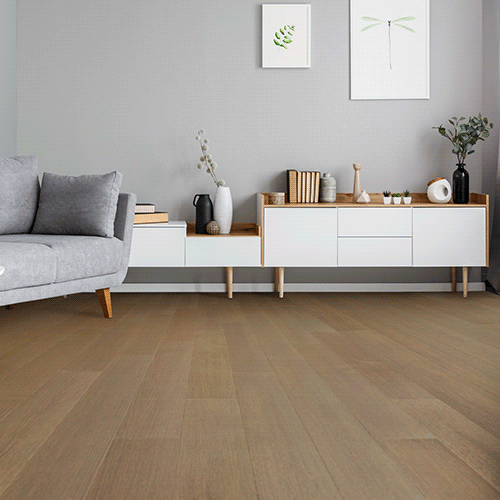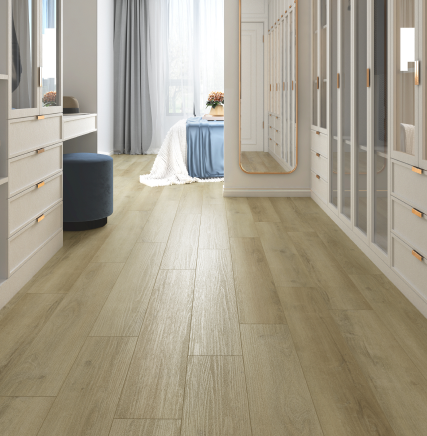HOW LAMINATE FLOORING IS MANUFACTURED
Wood laminate flooring is a hard surface floor which provides versatility, durability and high end style with the look of natural hardwood floors. Laminate flooring is manufactured with a layered construction using numerous layers pressed together, creating a wood-look floor. The lamination process uses heat and high pressure to fuse the materials together, resulting in a solid piece of flooring. With a visual "picture" layer and a matching textured topcoat, laminate flooring mimics the look and feel of solid hardwood flooring.
Laminate Flooring Layers
BOTTOM LAYER
The bottom layer of laminate flooring is composed of melamine backer, which aids in moisture resistance. This backer helps to balance the overall structure of laminate flooring by making the top layer and the bottom layer the same weight. The materials used to make the melamine backer are similar to the material used in the topcoat, which help the planks remain consistently flat.
Paper is sometimes used as a backer with laminate flooring, but melamine is a stronger material. With the added ability to prevent cupping and twisting, melamine backer adds additional support and overall strength to laminate flooring that paper backing lacks.
CORE LAYER
The core layer is perhaps the most important (and largest) part of laminate flooring. It is constructed using high density fiberboard (HDF), which is made of compressed wood particles, resins, polymers and plastics.
The resins and plastic in the core layer help offer higher water resistance. The level of resin used in the core layer of laminate flooring allows it to acclimate more easily to temperatures and humidity levels. Furthermore, higher levels of resin help prevent boards from adjusting and creating gaps or peaks once installed. Resin also can reduce some of the noise heard when walking on laminate floor. This type of prevention gives laminate flooring an edge over hardwood flooring, which can be more susceptible to humidity and temperature changes.
The core layer of high density fiberboard is constructed using both hard and soft woods. The natural resins found in soft woods aid in the bonding of the fibers in the board once compressed.
HDF is often constructed using recycled materials. The wood particles from hard and soft woods are processed into small particles and glued together. Since the pieces are small, scraps of wood from other building and manufacturing can be used to create HDF.
The use of high density fiberboard in the core layer stabilizes the laminate and helps to increase overall impact resistance. HDF is dense in nature and helps reduce the level of sound in a room.
VISUAL LAYER
The visual layer, or image layer, of laminate flooring is mainly decorative. This layer, along with the topcoat, has advanced in recent years to create a more realistic wood-look surface. The visual layer is created using a high resolution 3D photograph of real, natural wood grain. Multiple pictures are taken using a variety of grain patterns to provide a non-repetitive look. This accounts for the differences between the textures of planks of hardwood flooring – where no two boards are exactly the same.
These realistic images are then glued to the core layer to give the look of real wood texture. Some planks may have images of two to three narrower "planks" in a row to create the look of a number of planks on a single strip of laminate.
The intricate process of photographing real wood using the latest technologies produces a laminate flooring product that mimics the unique look of genuine hardwood floors.
TOPCOAT
The topcoat layer of laminate flooring is a translucent, clear finish applied to help protect the other layers and to enhance the durability of laminate flooring. The melamine, urethane-based aluminum oxide finish resists fading caused by UV rays, abrasions, everyday wear, and stains from accidental spills. The mixture of the materials used and the process to create them results in a product with a strong surface, which can be textured to mimic the imperfections of a genuine wood surface.
The top-coating process has advanced in recent years, providing realistic, embossed finishes that match the visual layer of the floor. Additionally, new technologies allow for unique wood-look finishes, including hand scraped, wire-brushed, and smooth high gloss styles.
Aluminum Oxide
Aluminum Oxide is a translucent, clear finish applied to the top of the laminate plank to help protect the laminate floor. The aluminum oxide is ground into a powder form and added to the melamine-urethane mixture of resin and cellulose. Combining these specific materials enhances the strength of the laminate and helps increase the level of water resistance, fade resistance, and scratch resistance.
The dense aluminum oxide aids the protective attributes of a basic "flash cured" urethane coating. Adding the aluminum oxide finish provides an additional protective barrier to laminate floors, which helps keep the "new floor look" intact without sacrificing durability.
The finish is then "flash cured", a process which dries instantly, suspending the aluminum particles in the resin and creating a clear and shiny finish. Flash curing laminate floor is vital to the integrity of the finish because if allowed to "air dry", aluminum particles can float to the surface and dull the topcoat with a hazy finish.
Multiple coats of the finish are applied to create the top layer. The more aluminum oxide is applied, the more durable the laminate flooring can become.
Finishes
There are three different decorative applications to add to the design of the finish, allowing laminate flooring to look and "feel" more like solid hardwood. These applications do not affect or enhance the durability of the finish – instead, they simply add texture and design. For more information, please see our Laminate Flooring Finishes page.
UNDERLAYMENT
The underlayment below laminate flooring is constructed using a composite of filaments and fibers laid together with a vapor barrier on top, which can keep moisture away. Thicker underlayment helps to insulate the floor and absorb impact during daily use. Underlayment can help absorb the clicking sound heard in floating floors, as long as it is sufficiently thick.
The materials in underlayment are mold and mildew resistant, making laminate a good flooring choice in most areas of the home or climate. The filaments and fibers help the underlayment absorb and evenly distribute moisture away from the bottom layer of the laminate. An added feature of underlayment is the versatility and flexibility it provides to form around sub-floor surface irregularities.
Laminate flooring mimics the appearance of genuine hardwood flooring without compromising durability and structural integrity. Protective materials and strong inner layers make the latest laminate flooring extremely durable as well. All in all, laminate flooring looks and feels very much like genuine hardwood, making it a viable flooring choice in almost any interior.



